ISSN
2307–3489 (Print), ІSSN
2307–6666
(Online)
Наука
та прогрес транспорту. Вісник
Дніпропетровського
національного університету залізничного
транспорту, 2019, №
2(80)
Інформаційно-комунікаційні
технології та
математичне моделювання
Інформаційно-комунікаційні
технології та
математичне моделювання
UDC
004.7.032.26:656.222.3
V. M. PAKHOMOVA1*,
T. I. SKABALLANOVICH2*,
V. S. BONDAREVA3*
1*Dep.
«Electronic Computing Machines», Dnipro National University of
Railway Transport
named after Academician V. La-zaryan, Lazaryan St.,
2, 49010, Dnipro, Ukraine,
tel. +38 (056) 373 15 89, e-mail
viknikpakh@gmail.com, ORCID 0000-0002-0022-099X
2*Dep.
«Electronic Computing Machines», Dnipro National University of
Railway Transport
named after Academician V. La-zaryan, Lazaryan St.,
2, 49010, Dnipro, Ukraine,
tel. +38 (056) 373 15 89, e-mail
sti19447@gmail.com, ORCID 0000-0001-9409-0139
3*Dep.
«Electronic Computing Machines», Dnipro National University of
Railway Transport
named after Academician V. La-zaryan, Lazaryan St.,
2, 49010, Dnipro, Ukraine,
tel. +38 (056) 373 15 89, e-mail
bond290848@gmail.com, ORCID 0000-0002-4016-1656
INTELLIGENT
ROUTING IN THE
NETWORK OF INFORMATION and
TELECOMMUNICATION SYSTEM OF RAILWAY TRANSPORT
Purpose. At the
present stage, the strategy of informatization of railway transport
of Ukraine envisages the transition to a three-level management
structure with the creation of a single information space, therefore
one of the key tasks remains the organization of routing in the
network of information and telecommunication system (ITS) of railway
transport. In this regard, the purpose of the article is to develop a
method for determining the routes in the network of information and
telecommunication system of railway transport at the trunk level
using neural network technology. Methodology.
In order to determine the routes in the network of the information
and telecommunication system of railway transport, which at present
is working based on the technologies of the Ethernet family, one
should create a neural model 21-1-45-21, to the input of which an
array of delays on routers is supplied; as a result vector – build
tags of communication channels to the routes. Findings.
The optimal variant is the neural network of configuration 21-1-45-21
with a sigmoid activation function in a hidden layer and a linear
activation function in the resulting layer, which is trained
according to the Levenberg-Marquardt algorithm. The most quickly the
neural network is being trained in the samples of different lengths,
it is less susceptible to retraining, reaches the value of the mean
square error of 0.2, and in the control sample determines the optimal
path with a probability of 0.9, while the length of the training
sample of 100 examples is sufficient. Originality.
There were constructed the dependencies of mean square error and
training time (number of epochs) of the neural network on the number
of hidden neurons according to different learning algorithms:
Levenberg-Marquardt; Bayesian Regularization; Scaled Conjugate
Gradient on samples of different lengths. Practical
value.
The use of a multilayered neural model, to
the entry of which the delay values of routers are supplied, will
make it possible to determine the corresponding routes of
transmission of control messages (minimum value graph) in the network
of information and telecommunication system of railway transport at
the trunk level in the real time.
Keywords:
information and telecommunication system; ITS; router delay; neural
network; NN; sample; activation function; learning algorithm; epoch;
error
Introduction
Until
recently, the work of the railway transport of Ukraine was the
interaction of six railways, on each of which an appropriate
information and telecommunication system (ITS) was implemented. The
main focus of the development of ITS rail networks is the use of
Ethernet (Ethernet, Fast Ethernet, Gigabit Ethernet) family
technologies that provide a 10/100/1000 Mbps hierarchy and the use
of the TCP/IP protocol stack [9].
The most important part of ITS of railway transport is the data
transmission network, which is a three-level hierarchical structure
and has the following levels: trunk, road, linear. The
node of the data transmission network belongs to the trunk level, if
it includes, besides the connections to the nodes of the data
transmission network of a particular railway, a connection to
the nodes of the data transmission network of other railways. Local
enterprise networks belong to the linear level, all other nodes of
the data network – to the road level.
To
build a
unified data
transmission
network of
Ukrzaliznytsia,
the network
equipment of
Cisco [13],
which is
an integrated
software and
hardware
complex, was
selected. One
of the key tasks is the organization of routing in the railway
transport ITS network. The current
routing protocol
(OSPF protocol)
uses the
search for
the shortest
path on
the graph,
the real-time
implementation
of which
causes some
difficulties, so
it is
advisable to
find solutions
to the
routing problem
using the
methods of
artificial
intelligence
[10, 13-20] and
study them
[1-4, 7]. For
example, for
the search
of the
shortest path
on the
route graph
in the
railway
transport ITS,
we analyzed
the possibility
of using
the Hopfield
network, ant
colony and
genetic methods
[8], for the
integrated
network of
ITS of
railway
transport, that
in the
prospect should
work on
different
technologies, we
defined the
optimal route
by the
means of
the software
model
«MLP34-2-410-34»,
the input
of which
is an
array of
bandwidth
network channels
[17]. In
addition to
the parameters
studied
(distance
between routers,
channel bandwidth)
it is
appropriate to
conduct
a
study of
other
parameters, such
as: service
availability; line
losses; router
delays.
Purpose
To develop a routing
methodology in the ITS network of rail transport at the trunk level
using the neural network technology.
Methodology
Let us
consider a fragment of a hypothetical network of railway transport
ITS presented in Fig. 1.
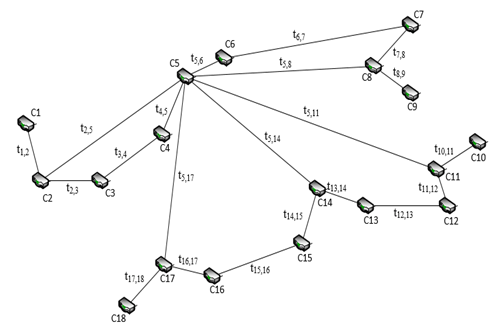
Fig. 1.
Graph of routers connections of hypothetical network of information
and telecommunication system (ITS) of railway
transportDesignations: C1 – Rivne; С2
– Lviv; C3 – Ternopil; C4 – Khmelnytskyi; С5
– Kyiv; C6 – Nizhyn; С7
– Poltava; С8 –
Kharkiv; С9 – Sumy; С10
– Luhansk; C11 – Donetsk; C12 – Krasnoarmiisk; C13 –
Chaplyne; С14 – Dnipro;
С15 – Zaporizhzhia; C16 –
Znamianka; С17 – Odesa;
C18 – Izmail
The ITS
network of rail transport may be represented as a weighted graph G
(V, W), where V
is the set of vertices of the graph whose number is equal to B
(B = 18), with each vertex modeling a
node (router) of the network; W is
the set of edges of the graph, each edge simulates the relationship
between the nodes, the number of graph edges is equal to M
(M = 21).
Each edge of
the graph is assigned with a certain weight
tij.
Since the channel transmission time is
much smaller, it is expedient to use the router delay time when
transmitting data from the i-th
to j-th
router of the ITS network of railway transport, as a weight, in μs.
It is
necessary to determine the minimal spanning tree (MST) of the rail
transport ITS network, that is, to find such a graph
 ,
where
,
where
 and
and
 ,
in addition
,
in addition
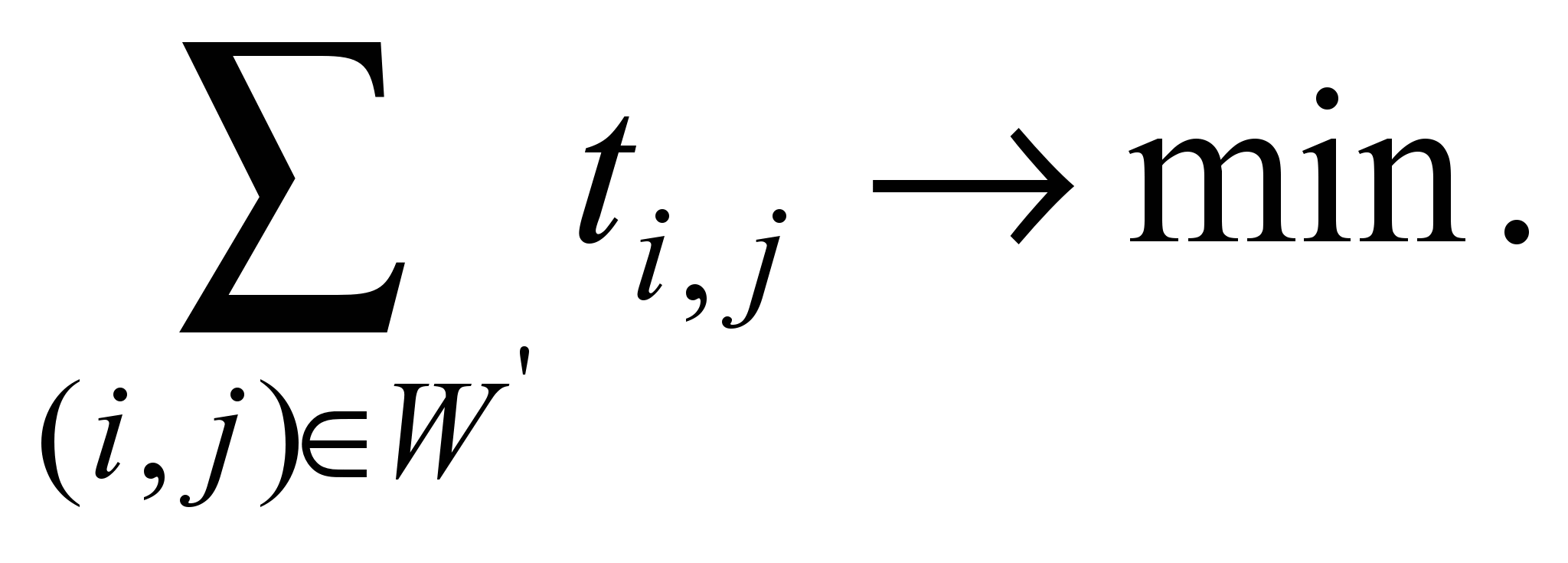 (1)
(1)
The construction of MST is
useful for distributing messages addressed to all nodes of the ITS
network of rail transport at the trunk level, for example, the
control messages from the main node (Kyiv), then the weight of the
whole spanning tree is the cost of sending a message to all its
nodes. It should also be noted that if all the weights of the graph
edges are different then there is only one MST of the network.
Neural
network as the main mathematical device for solving the problem.
To determine the MST in the ITS network of rail transport, we used a
two-layer neural network (NN), the input vector of which is a
plurality of delays on routers and consists of 21 neurons, the
resulting vector is build tags of communication channels to the
routes, and also consists of 21 neurons. The corresponding NN
structure is shown in Fig. 2.
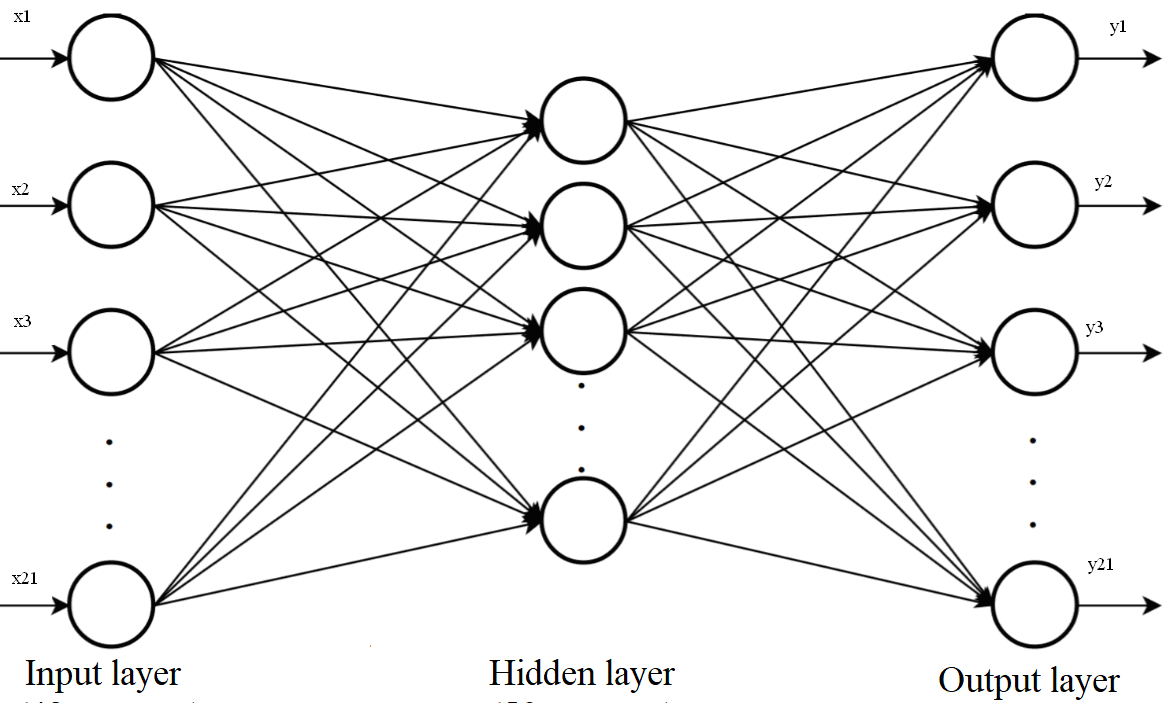
Fig. 2. Structure of the
two-layer neural network (NN)
As an
activation function of a hidden layer it is appropriate to use the
sigmoidal function, which is presented in Fig. 3, a,
in the resulting layer – a linear function shown in Fig. 3, b.
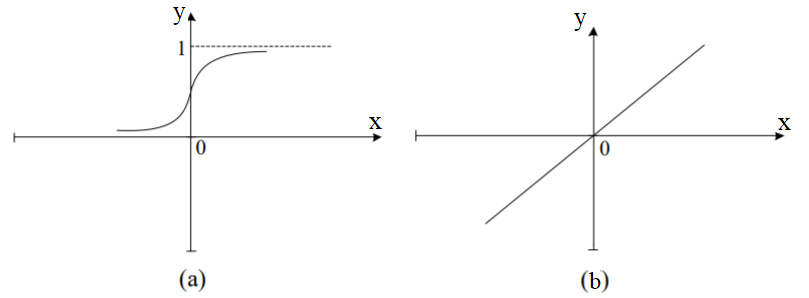
Fig.
3. Activation function graphs:
а
– sigmoid;
b
–
linear
Determination
of the number of neurons in NN layers is performed using the
following formula:
 (2)
(2)
where
 – the
number
of
synaptic
weights;
n
–input
signal
dimension;
m
–
output
signal
dimension;
N
–
the number
of
sample
elements.
– the
number
of
synaptic
weights;
n
–input
signal
dimension;
m
–
output
signal
dimension;
N
–
the number
of
sample
elements.
In
this
case
 .
Having
estimated
the
required
number
of
synaptic
weights
.
Having
estimated
the
required
number
of
synaptic
weights
 ,
we
calculate
the
required
number
of
neurons
in
the
hidden
layer
k according
to
the
known
formula:
,
we
calculate
the
required
number
of
neurons
in
the
hidden
layer
k according
to
the
known
formula:
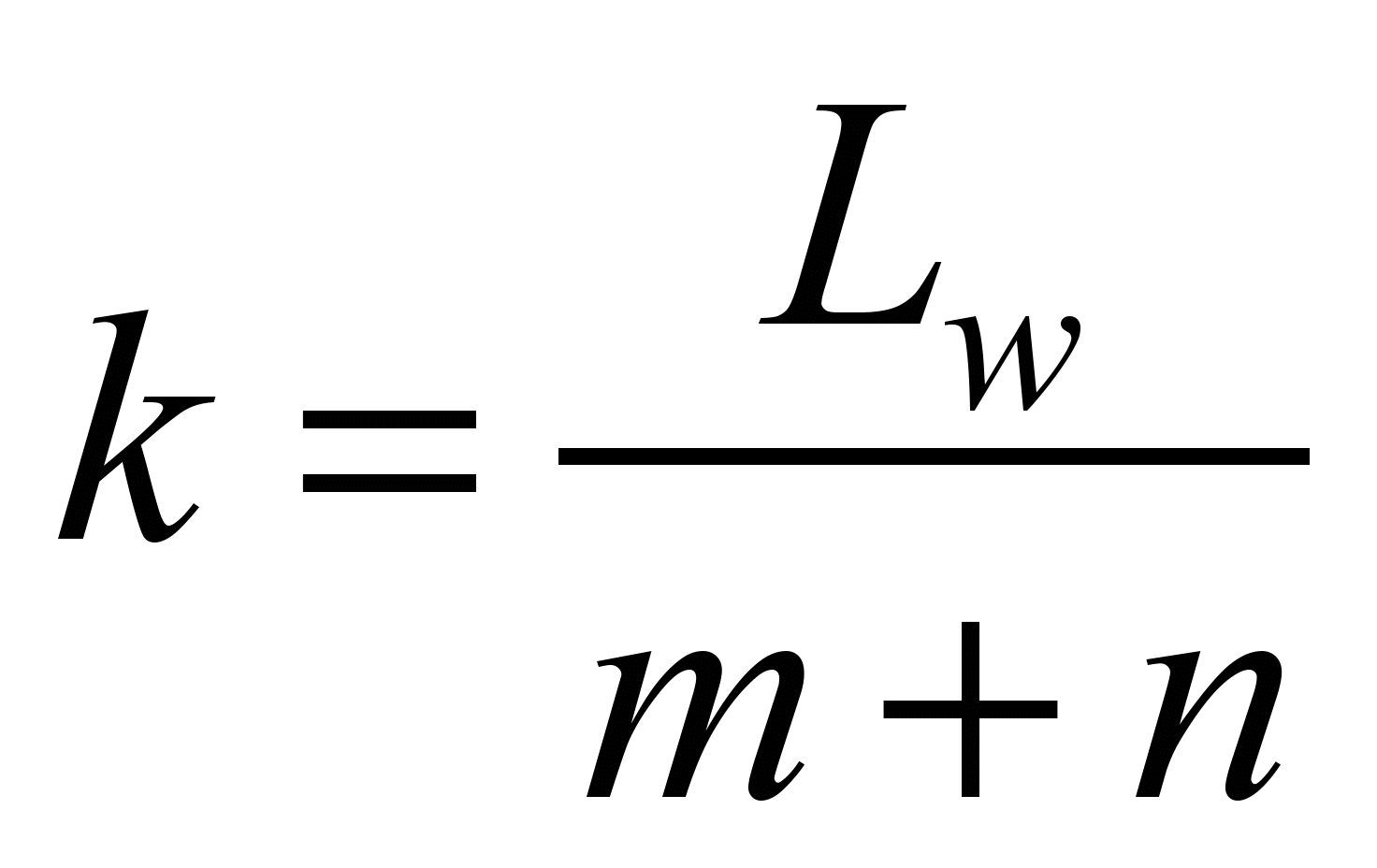 . (3)
. (3)
If you take
 ,
then the number of neurons in the hidden layer will be 45.
,
then the number of neurons in the hidden layer will be 45.
The training
of a multi-layered NN involves the use of the reverse error
propagation algorithm. The
training samples
are used for learning.
The basis of NM training is the minimization of some target
function, which depends on the parameters of the neurons and
infinity
of
training samples. As a minimizing target error function of a
multilayer NN, the function of the following type is taken:
 , (4)
, (4)
where
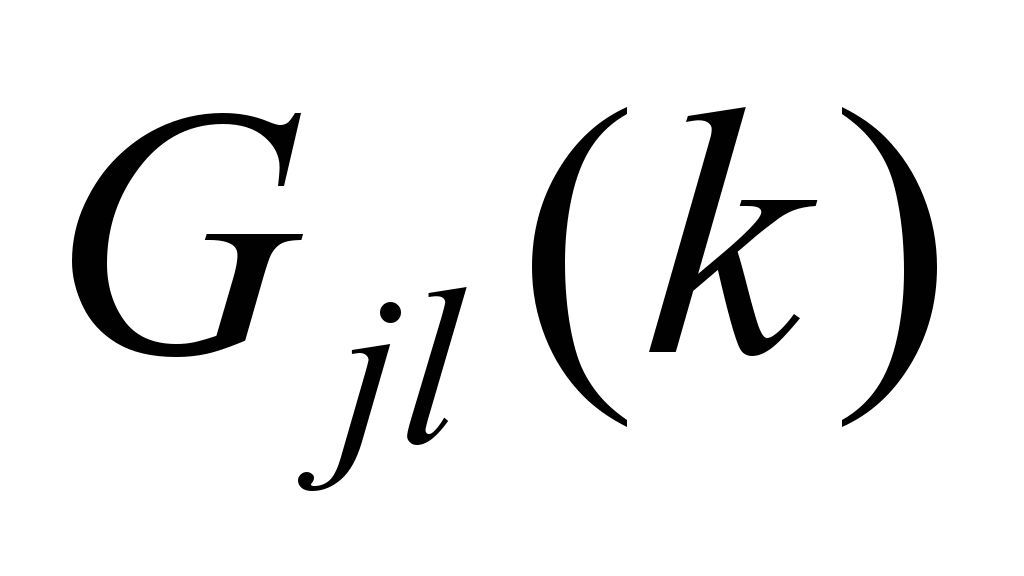 – desired
output of the j-th
neuron of the l-th
output layer for k-th
sample of the reference set;
– desired
output of the j-th
neuron of the l-th
output layer for k-th
sample of the reference set;  – actual
output of the j-th
neuron of the l-th
output layer when supplied
to the k-th
sample network input from the reference set.
– actual
output of the j-th
neuron of the l-th
output layer when supplied
to the k-th
sample network input from the reference set.
Preparation
of the general sample (preparatory stage).
The formation
of a
general sample
of NN
was carried
out for
a fragment
of a
hypothetical
network of
railway ITS (see
Fig. 1).
Sample data are obtained on the
corresponding simulation model of the ITS network of rail transport,
created with assistance of the Master A. Piskun in modelling system
OpNet Modeler [6] using
Gigabit Ethernet
technology under
the following
conditions:
protocol –
TCP; type
of traffic
– FTP; traffic
intensity –
600 MB/s;
package length
– 700 bytes;
operation time
of the
network simulation
model – 14
min. Learning
vectors are formed in the form of tables using the Excel package in
two files. In the first file «input.xml», the data submitted to
the NN input, are presented in the form of 21 vectors;
a
fragment of contents of the file «input.xml» is shown in Fig. 4.
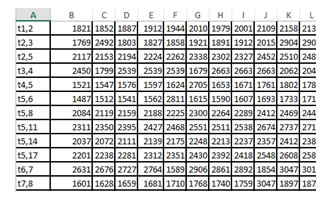
Fig.
4. Fragment of contents of the file «input.xml»
In the
second file «target.xml», the data submitted to the NN output are
also represented as 21 vectors; a fragment of contents of the
«target.xml» file is shown in Fig. 5.
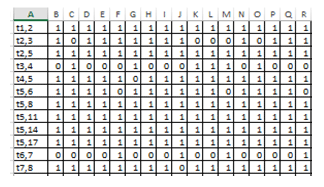
Fig. 5.
Fragment of contents of the file «target.xml»
Creating
a neural
network.
Neural Network Toolbox for the MatLab
environment was chosen as a neural package to solve the problem of
routing the rail transport ITS network. Using Import Data on the
Matlab toolbar, the data were imported from the created Excel-table.
Training,
testing and
analysis of
NN work
are carried
out on
appropriate
samples
(Training,
Testing and
Validation),
whose percentage
from the
general sample
is shown
in Fig.
6.
The «Network Architecture»
window provides the required number of hidden neurons (Figure 7).
Fig.
8 shows the structure of the created neural network.

Fig. 6. Data
validation and testing window

Fig. 7.
Setting the hidden neurons

Fig. 8.
Structure of the created NN
Teaching
and testing of neural network. In the
Train Network window, one of the three proposed learning algorithms
for the NN (Levenberg-Marquardt, Bayesian Regularization, and Scaled
Conjugate Gradient) is selected. For example, learning of the
21-1-45-21 configuration NN by the Levenberg-Marquardt algorithm
took place during 11 epochs, the time spent was 26 s (Fig. 9).
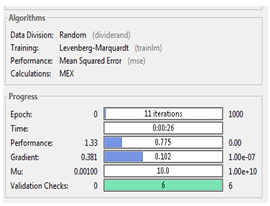
Fig. 9.
Characteristics of the NN training
Mean Squared
Error (MSE) is the mean square deviation between output and target;
the lower the value, the better; zero means no error. The value of
regression R
means the correlation between output and target. If R
= 1, this means close correlation, zero is a random relationship.
The MSE values of training, validation and testing of the neural
network made 0.204, 0.186 and 0.183, respectively; R
has a value of 0.38, 0.43 and 0.44, respectively (Fig. 10).
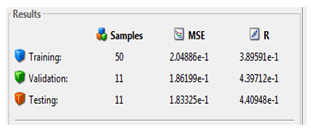
Fig.
10 Results of the NN 21–1–45–21
Regression
diagrams and error histograms of the 21-1-45-21 configuration NN by
the Levenberg-Marquardt algorithm are presented in Fig. 11.
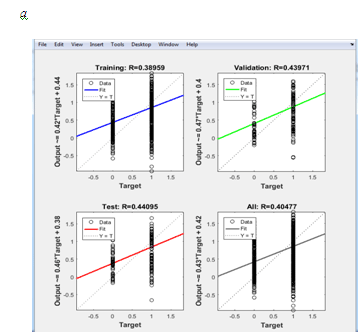
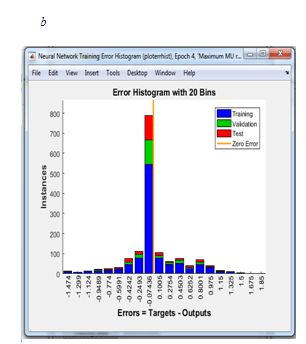
Fig. 11. Graphical
presentation of results of NN 21-1-45-21:
а
– regression
diagrams;
б
– error
histogram
Findings
Analysis
of the neural network operation.
Based
on the results obtained on the 21-1-45-21 configuration NN, the MST
of the ITS network of railway transport was built and presented in
Fig. 12 (the bold line shows the route for sending control messages
from Kyiv).
According to
the Kruskal algorithm [5] (without using NN), the MST of the ITS
network of railway transport was
built, as shown in Fig. 13.
As can be
seen from Fig. 12-13, the results coincided, that is, the NN of
configuration 21-1-45-21 works correctly. Ten launches were
conducted on this NN, the data obtained are summarized in Table 1.
From the
table it is clear that the probability of building the MST of the
ITS network of rail transport is 0.9 (experiments No. 1-2, 4-10),
herewith in experiment No. 7 another MST was obtained (different
edges had the same value of weight), but the solution is correct
(Fig. 14), but in experiment No. 3, the solution provided by the NN
is, unfortunately, incorrect (gap in the route: separation of
C1-C2-C3 fragment from C5, which is the source of sending control
messages), Fig. 15.
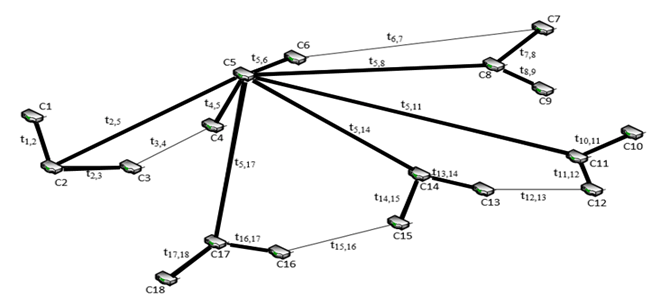
Fig. 12. MST of the ITS
network based on NN

Fig. 13. MST
the ITS network,
built by the
Kruskal algorithm
Designations:
edge weights – delays
on ITS network routers, µs
Table 1
Analysis of operation of
21-1-45-21configuration NN
|
Edge
weight
|
Organization
of experiments on NN
|
|
|
1
|
2
|
3
|
4
|
5
|
6
|
7
|
8
|
9
|
10
|
|
|
x
|
y
|
x
|
y
|
x
|
y
|
x
|
y
|
x
|
y
|
x
|
y
|
x
|
y
|
x
|
y
|
x
|
y
|
x
|
y
|
|
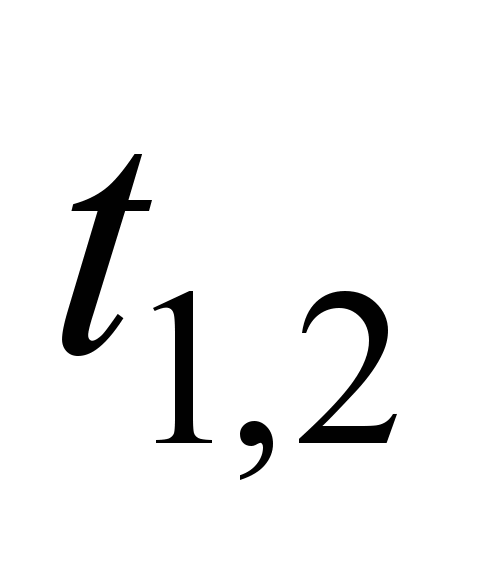
|
1 828
|
1
|
1 859
|
1
|
1 895
|
1
|
2
549
|
1
|
2 549
|
1
|
1 686
|
1
|
2 674
|
1
|
2 674
|
1
|
2 674
|
1
|
2 070
|
1
|
|
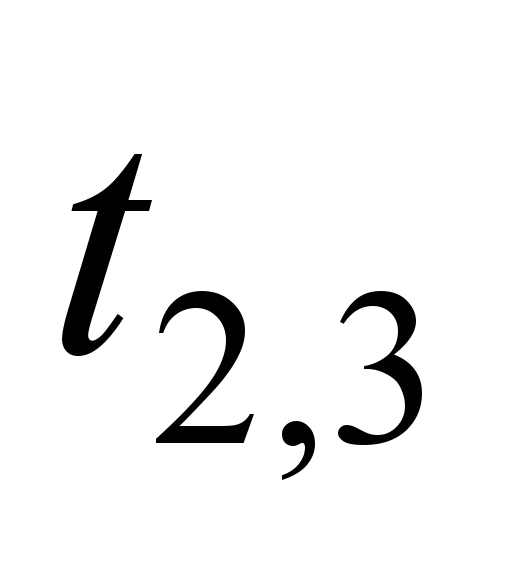
|
1 776
|
1
|
2 502
|
1
|
1 810
|
1
|
1 603
|
1
|
1 630
|
1
|
2 716
|
1
|
1 660
|
1
|
1 678
|
1
|
1 768
|
1
|
1 809
|
1
|
|
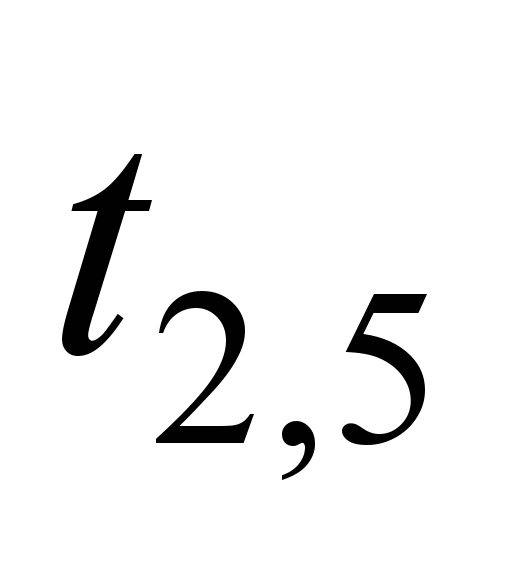
|
2 125
|
1
|
2 162
|
1
|
2 549
|
1
|
1 568
|
1
|
2 822
|
1
|
1 621
|
1
|
1 596
|
1
|
1 613
|
1
|
1 700
|
1
|
1 740
|
1
|
|
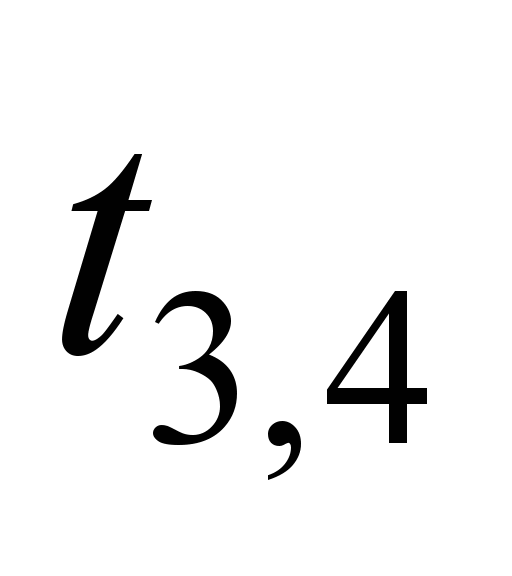
|
2 460
|
0
|
1 806
|
0
|
2 598
|
0
|
2 197
|
0
|
2 234
|
0
|
2 309
|
0
|
2 273
|
0
|
2 298
|
0
|
2 422
|
0
|
2 479
|
0
|
|

|
1 527
|
1
|
1 553
|
1
|
1 582
|
1
|
2 437
|
1
|
2 478
|
1
|
2 561
|
1
|
2 521
|
1
|
2 548
|
1
|
2 685
|
1
|
2 748
|
1
|
|

|
1 493
|
1
|
1 518
|
1
|
1 547
|
1
|
2 148
|
1
|
2 184
|
1
|
2 257
|
1
|
2 222
|
1
|
2 246
|
1
|
2 366
|
1
|
2 422
|
1
|
|

|
2 092
|
1
|
2 127
|
1
|
2 168
|
1
|
2 321
|
1
|
2 360
|
1
|
2 440
|
1
|
2
402
|
1
|
2 428
|
1
|
2 558
|
1
|
2 618
|
1
|
|

|
2 320
|
1
|
2 359
|
1
|
2 405
|
1
|
2 775
|
1
|
1 595
|
1
|
2 918
|
1
|
2 872
|
1
|
2 904
|
1
|
1 861
|
1
|
3 059
|
1
|
|

|
2 045
|
1
|
2 080
|
1
|
2 119
|
1
|
1 688
|
1
|
1 717
|
1
|
1 775
|
1
|
1 747
|
1
|
1 766
|
1
|
3 059
|
1
|
1 905
|
1
|
|

|
2 210
|
1
|
2 247
|
1
|
2 290
|
1
|
1 793
|
1
|
1 823
|
1
|
1
885
|
1
|
1 855
|
1
|
1 875
|
1
|
1 976
|
1
|
2 022
|
1
|
|

|
2 642
|
0
|
2 687
|
0
|
2 738
|
0
|
2 108
|
0
|
2 145
|
0
|
2 217
|
0
|
2 183
|
0
|
2 207
|
0
|
2 325
|
0
|
2 379
|
0
|
|

|
1 607
|
1
|
1 635
|
1
|
1 666
|
1
|
2 029
|
1
|
2 063
|
1
|
2 132
|
1
|
2 099
|
1
|
2 856
|
1
|
2 237
|
1
|
2 289
|
1
|
|

|
1 707
|
1
|
1 736
|
1
|
1 769
|
1
|
1 723
|
1
|
1 752
|
1
|
2 870
|
1
|
2 825
|
1
|
2 122
|
1
|
3 010
|
1
|
3 080
|
1
|
|

|
2 007
|
1
|
2 041
|
1
|
2 080
|
1
|
2 731
|
1
|
2 777
|
1
|
1 811
|
1
|
1 783
|
1
|
1 802
|
1
|
1 899
|
1
|
1 943
|
1
|
|

|
1 932
|
1
|
1 965
|
1
|
2 002
|
1
|
1 667
|
1
|
1 695
|
1
|
1 752
|
1
|
2 749
|
1
|
1 744
|
1
|
1 837
|
1
|
1 880
|
1
|
|

|
2 600
|
0
|
2 645
|
0
|
2 695
|
0
|
2 656
|
0
|
2 701
|
0
|
2 792
|
0
|
1 725
|
0
|
2 779
|
0
|
2 929
|
0
|
2 255
|
0
|
|

|
1 640
|
1
|
1 668
|
1
|
1 700
|
1
|
2 000
|
1
|
2 034
|
1
|
2 102
|
1
|
2 069
|
1
|
2 091
|
1
|
2 204
|
1
|
2 997
|
1
|
|

|
1 586
|
1
|
1 613
|
1
|
1 645
|
1
|
1 910
|
1
|
1 942
|
1
|
2 007
|
1
|
1 976
|
0
|
1 997
|
1
|
2 104
|
1
|
2 154
|
1
|
|

|
2 528
|
0
|
2 571
|
0
|
1 974
|
1
|
2 549
|
0
|
2 549
|
0
|
1 686
|
0
|
2 692
|
1
|
2 564
|
0
|
2 642
|
0
|
2 070
|
0
|
|

|
1 905
|
1
|
1 937
|
1
|
2 620
|
0
|
1 628
|
1
|
1 647
|
1
|
2 756
|
1
|
1 658
|
1
|
1 678
|
1
|
1 771
|
1
|
1 816
|
1
|
|

|
1 818
|
1
|
1 849
|
1
|
1 885
|
1
|
1 583
|
1
|
2 872
|
1
|
1 692
|
1
|
1 596
|
1
|
1 627
|
1
|
1 707
|
1
|
1 756
|
1
|
|
MAS
|
+
|
+
|
|
+
|
+
|
+
|
|
+
|
+
|
+
|
|
Correct
solution
|
|
|
|
|
+
|
|
|
|
|
Incorrect
solution
|
+
|
|
|
|
|
|
|
|
|
Note: Delay values on routers in the ITS
network of rail transport are given in μs
|
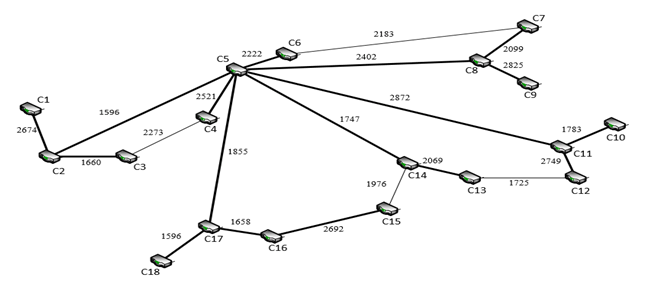
Fig.
14. MST of the ITS network built on the basis of NN (experiment No.
7)
Designations:
edge weights – delays on ITS network routers, µs
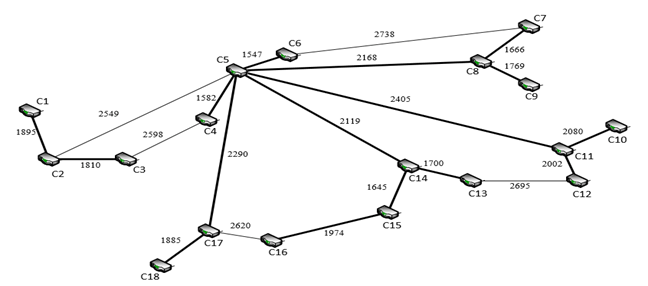
Fig. 15.
Incorrect solution obtained on NN (experiment No. 3)
Designations:
edge weights – delays on ITS network routers, µs
Originality
and practical value
Study of
the error and time of NN training on the number of hidden neurons by
different learning algorithms. Experiments
were performed on the NN of 21-1-X-21 configuration with a sigmoidal
activation function in the hidden layer and a linear activation
function in the output layer at 10, 45 and 90 hidden neurons using
the following algorithms: Levenberg-Marquardt;
Bayesian Regularization; Scaled Conjugate Gradient.
The results obtained are summarized in
Table 2.
Table
2
Error and time of NN training on the number of hidden neurons
|
Number
of hidden neurons
|
Levenberg-Marquardt
|
Bayesian
Regularization
|
Scaled
Conjugate Gradient
|
|
MSE
|
Number
of epochs
|
MSE
|
Number
of epochs
|
MSE
|
Number
of epochs
|
|
10
|
0.775
|
2
|
0.392
|
4
|
0.00770
|
125
|
|
45
|
0.204
|
11
|
0.870
|
5
|
0.00015
|
154
|
|
90
|
0.991
|
29
|
1.270
|
6
|
0.00004
|
302
|
The
dependence of error and time of NN training on the number of hidden
neurons by different learning algorithms is presented in Fig. 16.
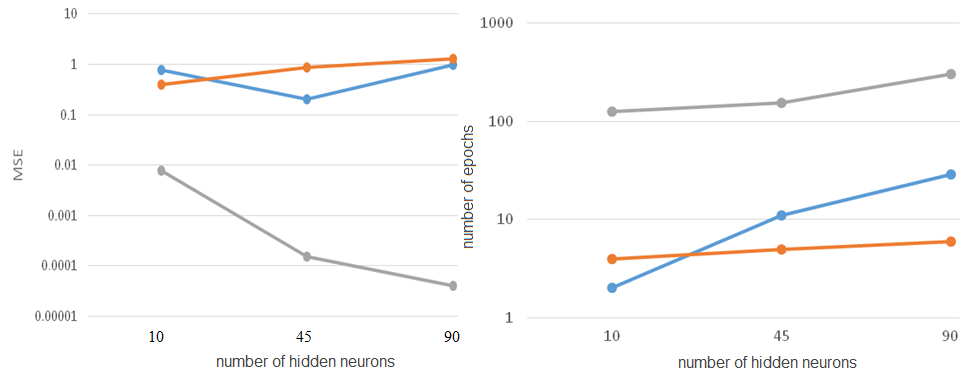
Fig. 16. MSE and NN training time versus the number of hidden
neurons
Designations:

From Fig.16 it can be seen that
with the increased number of neurons in the hidden layer, the time
of training for the 21-1-X-21 configuration NN increases, with 45
neurons in the hidden layer being optimal by the Levenberg-Marquardt
algorithm.
Study of
the error and time of training NN on the length of the training
sample by the Levenberg-Marquardt algorithm. Experiments
were performed on the 21-1-45-21 configuration NN with a sigmoid
activation function in the hidden layer and a linear activation
function in the output layer, while the length of the training
sample was 50, 100 and 152 examples. Dependence of the error and
time of training of the NN on the length of the training sample is
presented in Fig. 17. The Figure shows that the increased length of
the training sample results in decrease in the root mean square
error, while the training time of NN increases rapidly, but the use
of the sample with 100 examples for the NN training is sufficient.
The use of a
multilayered neural model, to the entry of which the delay values of
routers are supplied, will make it possible to determine the
corresponding routes of transmission of control messages
from Kyiv (minimum value graph) in the ITS
network of railway transport at the trunk level in the real time.
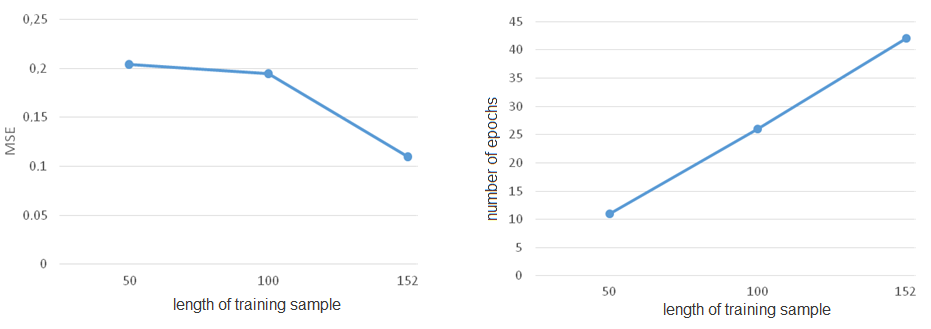
Fig.
17. MSE and NN training time versus the training sample
length
Conclusions
To
determine routes for sending the control messages in the ITS
network (at the trunk level) of railway transport using the Neural
Network Toolbox of the Matlab environment the neural network of
configuration 21-1-45-21 is created, to the input of which an array
of delays on the routers is supplied; as a result vector – build
tags of communication channels to the routes.
The neural
network of configuration
21-1-45-21 with a sigmoidal activation
function in the hidden layer and a linear function in the resulting
layer under the learning algorithm of Levenberg-Marquardt for 11
epochs gives the MSE value of 0.204, 0.186 and 0.183 in the
training, validation and testing samples, respectively. The result
given by the neural network coincides with the graph obtained by
the Kruskal algorithm. In addition, 10 experiments on the neural
network were conducted: the correct result is achieved with a
probability of 0.9.
On
the
21-1-X-21
neural
network,
a
study
was
made
of
the
mean
square
error
and time of training on the number of hidden neurons (10, 45 and
90) under different learning algorithms: Levenberg-Marquardt,
Bayesian Regularization, and Scaled Conjugate Gradient. It is
determined that the optimal variant is the configuration 21-1-45-21
by the Levenberg-Marquardt algorithm.
On the
21-1-45-21configuration neural network, there was conducted the
study of the mean square error and the time of training depending
on the length of the training sample: 50, 100 and 152 examples
using the Levenberg-Marquardt algorithm. It is determined that the
increased length of the training sample results in decrease in the
root mean square error, while the training time of the neural
network increases rapidly, but the use of the sample with 100
examples for its training is sufficient.
LIST OF REFERENCE LINKS
Асланов,
А. М. Исследование интеллектуального
подхода в маршрутизации компьютерных
сетей /
А. М. Асланов, М. С. Солодовник
// Электротехнические и компьютерные
системы. – 2014. – № 16 (92).
– С. 93–100.
Білоус,
Р. В. Особливості прикладного застосування
генетичного алгоритму пошуку оптимальних
шляхів / Р. В. Білоус, С. Д. Погорілий //
Реєстрація, зберігання і обробка даних.
– 2010. – Т. 12, № 2. – C. 81–87.
Колесников,
К. В. Нейросетевые модели оптимизации
маршрутов доставки данных в динамических
сетях /
К. В. Колесников, А. Р. Карапетян, А. С.
Курков // Международный научный журнал.
– 2015. – № 6. – С.
74–77.
Колесніков,
К. В. Аналіз результатів дослідження
реалізації задачі маршрутизації на
основі нейронних мереж та генетичних
алгоритмів / К. В. Колесніков, А. Р.
Карапетян, В. Ю. Баган //
Вісн. Черкас. держ. технол. ун-ту. Серія:
Технічні науки : зб. наук. пр. – Черкаси,
2016. –
№ 1. – C. 28–34.
Минимальное
остовное дерево.
Алгоритм Крускала
[Electronic resource] //
MAXimal. –
2008. – Available at: http://e-maxx.ru/algo/mst_kruskal
– Title
from the screen. – Accepted
:
15.05.2018.
Никитченко,
В. В. Утилиты моделирующей системы
Opnet Modeler
/ В. В. Никитченко.
– Одесса
: Одес.
нац.
акад.
связи им. А.
С. Попова,
2010. – 128 с.
Павленко,
М. А. Анализ возможностей искусственных
нейронных сетей для решения задач
однопутевой маршрутизации в ТКС
[Electronic resource]
/ М. А. Павленко // Проблеми
телекомунікацій.
– 2011. – № 2 (4).
– Available at:
http://pt.journal.kh.ua/index/0-139 – Title
from the
screen. – Accepted
: 20.11.2018.
Пахомова,
В. М. Аналіз методів з природними
механізмами визначення оптимального
маршруту в комп’ютерній мережі
Придніпровської залізниці / В. М.
Пахомова, Р. О. Лепеха // Інформ.-керуючі
системи на залізн. трансп. – 2014. – №
4. – С. 82–91.
Пахомова,
В. М. Дослідження інформаційно-телекомунікаційної
системи залізничного транспорту з
використанням штучного інтелекту :
монографія / В. М. Пахомова. – Дніпро :
Стандарт-Сервіс, 2018. – 220 с.
Погорілий,
С. Д. Генетичний алгоритм розв’язання
задачі маршрутизації в мережах / С. Д.
Погорілий, Р. В. Білоус // Проблеми
програмування. – 2010. – № 2-3. – С. 171–178.
Реалізація
задачі вибору оптимального авіамаршруту
нейронною мережею Хопфілда / А. М.
Бриндас, П. І. Рожак, Н. О. Семенишин, Р.
Р. Курка // Наук. вісн. НЛТУ України : зб.
наук.-техн. пр. – Львів, 2016. –
Вип. 26.1. –
С. 357–363.
CiscoTips
[Electronic
resource] :
[веб-сайт]. – Електрон. текст. дані. –
Available at:
http://ciscotips.ru/ospf/
– Title
from the screen. – Accepted
: 20.05.2018.
Dorigo,
M. Ant Colony System: A Cooperative Learning Approach to the
Traveling Salesman Problem /
M. Dorigo, L. M. Gambardella //
IEEE Trans. on Evolutionary Compytation. – 1997. – Vol.
1. – Iss.
1. –
Р. 53–66.
doi: 10.1109/4235.585892
Hopfield,
J. J. Neural networks and physical systems with emergent collective
computational abilities /
J.
J. Hopfield // Proceedings of National Academy of Sciences. –
1982. – Vol.
79. – Іss.
8. – P.
2554–2558.
doi: 10.1073/pnas.79.8.2554
Neural
Network Based
Near-Optimal
Routing
Algorihm /
Chang Wook Ahn, R. S.
Ramakrishna, In Chan Choi, Chung Gu Kang
// Neural
Information Processing – ICONIP’02 : Proc. of the 9th Intern.
Conf. (18–22
Nov. 2002).
–
Singapore,
2002. – P.
1771–1776.
New
algorithm for packet routing in mobile ad-hoc networks / N. S.
Kojić, M. B. Zajeganović-Ivančić,
I. S. Reljin, B. D.
Reljin // Journal of Automatic Control. – 2010. – Vol. 20.
– Іss.
1. – P. 9–16.
doi: 10.2298/JAC1001009K
Pakhomova,
V. M.
Optimal route definition in the network
based on the multilayer neural model /
V. M. Pakhomova, I. D.
Tsykalo // Наука та прогрес
транспорту. –
2018. – № 6 (78). – P.
126–142.
doi:
10.15802/stp2018/154443
Schuler,
W. H. A novel hybrid training method for hopfield neural networks
applied to routing in communications networks / W. H. Schuler, C.
J. A. Bastos-Filho, A. L. I. Oliveira // International Journal of
Hybrid Intelligent Systems. – 2009. – Vol. 6. – Іss.
1. – P. 27–39.
doi: 10.3233/his-2009-0074
Towards
QoS-aware routing for DASH utilizing MPTCP over SDN / K. Herguner,
R. S. Kalan, C. Cetinkaya, M. Sayit // IEEE
Conference on Network Function Virtualization and Software Defined
Networks (NFV-SDN) (6–8
Nov. 2017).
–
Berlin, Germany,
2017. – P.
1–6. doi:
10.1109/nfv-sdn.2017.8169844
Zhukovyts’kyy,
I. Research of Token Ring network options in automation system of
marshalling yard /
I. Zhukovyts’kyy, V. Pakhomova
// Transport Problems. – 2018. –
Vol. 13. –
Iss. 2. – P.
145–154.
doi: 10.20858/tp.2018.13.2.14
В. М. ПАХОМОВА1*,
Т. І. СКАБАЛЛАНОВИЧ2*,
В. С. БОНДАРЕВА3*
1*Каф.
«Електронні обчислювальні машини»,
Дніпровський національний університет
залізничного
транспорту імені академіка
В. Лазаряна, вул. Лазаряна, 2, Дніпро,
Україна, 49010, тел. +38 (056) 373 15 89,
ел. пошта
viknikpakh@gmail.com, ORCID 0000-0002-0022-099X
2*Каф.
«Електронні обчислювальні машини»,
Дніпровський національний університет
залізничного
транспорту імені академіка
В. Лазаряна, вул. Лазаряна, 2, Дніпро,
Україна, 49010, тел. +38 (056) 373 15 89,
ел. пошта
sti19447@gmail.com, ORCID
0000-0001-9409-0139
3*Каф. «Електронні
обчислювальні машини», Дніпровський
національний університет залізничного
транспорту імені академіка В. Лазаряна,
вул. Лазаряна, 2, Дніпро, Україна, 49010,
тел. +38 (056) 373 15 89,
ел. пошта
bond290848@gmail.com,
ORCID 0000-0002-4016-1656
ІНТЕЛЕКТУАЛЬНИЙ ПІДХІД ДО
ВИЗНАЧЕННЯ МАРШРУТІВ
У МЕРЕЖІ
ІНФОРМАЦІЙНО-ТЕЛЕКОМУНІКАЦІЙНОЇ
СИСТЕМИ ЗАЛІЗНИЧНОГО ТРАНСПОРТУ
Мета. На
сучасному етапі стратегія інформатизації
залізничного транспорту України
передбачає перехід
на трирівневу структуру керування зі
створенням єдиного інформаційного
простору, тому однією із ключових задач
залишається організація маршрутизації
в мережі інформаційно-телекомунікаційної
системи (ІТС). У зв’язку з цим метою
статті є розроблення методики визначення
маршрутів у мережі інформаційно-телекомунікаційної
системи залізничного транспорту на
магістральному рівні з використанням
нейромережної технології. Методика.
Для визначення маршрутів
у мережі інформаційно-телекомунікаційної
системи залізничного транспорту,
що на сучасному етапі працює за
технологіями родини Ethernet,
створено нейронну модель
21–1–45–21,
на вхід якої подають
масив затримок на маршрутизаторах. За
результуючий вектор взяті ознаки
входження каналів зв’язку до маршрутів.
Результати.
Оптимальним варіантом є нейронна мережа
(НМ) конфігурації 21–1–45–21
із сигмоїдальною функцією активації
у прихованому шарі й лінійною функцією
активації у результуючому шарі, що
навчається за алгоритмом
Levenberg-Marquardt. Нейронна
мережа навчається найбільш швидко на
вибірках різної довжини, менше за інші
піддається перенавчанню, досягає
значення середньоквадратичної помилки
в 0,2 і на
контрольній вибірці визначає оптимальний
шлях з імовірністю 0,9, при цьому достатньо
довжини навчальної вибірки зі 100
прикладів. Наукова
новизна. Побудовані
залежності середньоквадратичної
похибки й часу навчання нейронної
мережі (кількості епох) від кількості
прихованих нейронів за алгоритмами
навчання Levenberg-Marquardt,
Bayesian Regularization, Scaled Conjugate Gradient
на вибірках різної довжини.
Практична значимість.
Використання багатошарової нейронної
моделі, на вхід якої подають значення
затримок на маршрутизаторах, дозволить
у масштабі реального часу визначити
відповідні маршрути передачі керівних
повідомлень (граф мінімальної вартості)
в мережі
інформаційно-телекомунікаційної
системи залізничного транспорту на
магістральному рівні.
Ключові слова: інформаційно-телекомунікаційна
система; ІТС; затримка на маршрутизаторі;
нейронна мережа; НМ; вибірка; функція
активації; алгоритм навчання; епоха;
похибка
В. Н. ПАХОМОВА1*,
Т. И. СКАБАЛЛАНОВИЧ2*,
В. С. БОНДАРЕВА3*
1*Каф.
«Электронные вычислительные машины»,
Днипровский национальный университет
железнодорожного
транспорта имени
академика В. Лазаряна, ул. Лазаряна, 2,
Днипро, Украина, 49010, тел. +38
(056) 373 15 89,
эл. почта viknikpakh@gmail.com.,
ORCID 0000-0002-0022-099X
2*Каф.
«Электронные вычислительные машины»,
Днипровский национальный университет
железнодорожного
транспорта имени
академика В. Лазаряна, ул. Лазаряна, 2,
Днипро, Украина, 49010, тел. +38 (056) 373 15 89,
эл. почта sti19447@gmail.com,
ORCID 0000-0001-9409-0139
3*Каф.
«Электронные вычислительные машины»,
Днипровский национальный университет
железнодорожного
транспорта имени
академика В. Лазаряна, ул. Лазаряна, 2,
Днипро, Украина, 49010, тел. +38 (056) 373 15 89,
эл. почта bond290848@gmail.com,
ORCID 0000-0002-4016-1656
ИНТЕЛЛЕКТУАЛЬНЫЙ
ПОДХОД К ОПРЕДЕЛЕНИЮ МАРШРУТОВ
В
СЕТИ ИНФОРМАЦИОННО-ТЕЛЕКОММУНИКАЦИОННОЙ
СИСТЕМЫ ЖЕЛЕЗНОДОРОЖНОГО ТРАНСПОРТА
Цель. На
современном этапе стратегия информатизации
железнодорожного транспорта Украины
предусматривает переход на трехуровневую
структуру управления с созданием
единого информационного пространства,
поэтому одной из ключевых задач остается
организация маршрутизации в сети
информационно-телекоммуникационной
системы (ИТС). В связи с этим целью статьи
является разработка методики определения
маршрутов в сети информационно-телекоммуникационной
системы железнодорожного транспорта
на магистральном уровне с использованием
нейросетевой технологии. Методика.
Для определения маршрутов в сети
информационно-телекоммуникационной
системы железнодорожного транспорта,
которая на данном этапе работает по
технологиям семейства Ethernet,
создано нейронную модель 21–1–45–21, на
вход которой подают массив задержек
на маршрутизаторах сети. В качестве
результирующего вектора приняты
признаки включения каналов связи до
маршрутов. Результаты.
Оптимальным вариантом является нейронная
сеть (НС) конфигурации 21–1–45–21 с
сигмоидальной
функцией активации в скрытом слое и
линейной функцией активации в
результирующем слое, обучаемая по
алгоритму Levenberg-Marquardt.
Нейронная сеть обучается наиболее
быстро на выборках любой длины, менее
других подвержена переобучению,
достигает значения среднеквадратичной
ошибки в 0,2 и на контрольной выборке
определяет оптимальный путь с вероятностью
0,9, при этом достаточно длины обучающей
выборки со 100 примеров. Научная
новизна. Построены
зависимости среднеквадратичной
погрешности и времени обучения нейронной
сети (количества эпох) от количества
скрытых нейронов по алгоритмам обучения
Levenberg-Marquardt,
Bayesian Regularization,
Scaled Conjugate
Gradient на выборках различной
длины. Практическая
значимость. Использование
многослойной нейронной модели, на вход
которой подают значения задержек на
маршрутизаторах, позволит в масштабе
реального времени определить
соответствующие маршруты передачи
управляющих сообщений (граф минимальной
стоимости) в сети информационно-телекоммуникационной
системы железнодорожного транспорта
на магистральном уровне.
Ключевые слова: информационно-телекоммуникационная
система; ИТС; задержка на маршрутизаторе;
нейронная сеть; НС; выборка; функция
активации; алгоритм обучения; эпоха;
погрешность
REFERENCES
Aslanov, A. M., &
Solodovnik, M. S. (2014). Issledovanie
intellektualnogo podkhoda v marshrutizatsii kompyuternykh setey.
Elektrotekhnicheskie i kompyuternye
sistemy, 16(92), 93-100. (in Russian)
Bilous,
R. V.,
& Pohorilyi, S.
D. (2010).
Features of the Application of Genetic
Algorithm for Searching Optimal Paths on the Graph.
Reiestratsiia, zberihannia i obrobka danykh, 12(2),
81-87. (in Ukrainian)
Kolesnikov,
K. V.,
Karapetyan, A.
R.,
& Kurkov,
A. S. (2015).
Neural network modelsof data delivery
route optimization in dynamic networks.
International Scientific
Journal,
6, 74-77. (in Russian)
Kolesnikov,
K. V., Karapetian, A. R., &
Bahan, V. Y. (2016). Analiz rezultativ doslidzhennia realizatsii
zadachi marshrutyzatsii na osnovi neironnykh merezh ta henetychnykh
alhorytmiv. Visnyk Cherkaskogo
derzhavnogo tehnologichnogo universitetu. Seria: Tehnichni nauky,
1, 28-34. (in
Ukrainian)
Minimalnoe
ostovnoe derevo. Algoritm Kruskala. MAXimal.
Retrieved from
http://e-maxx.ru/algo/mst_kruskal
(in Russian)
Nikitchenko,
V. V. (2010). Utility modeliruyushchey
sistemy Opnet Modeler. Odessa:
Odesskaya nats-ionalnaya
akademiya svyazi im. A. S. Popova. (in Russian)
Pavlenko,
M. A. (2011). Analysis
opportunities of artificial neural networks for solving single-path
routing in telecommunication network. Problemy
telekomunikatsii, 2(4). Retrieved
from
http://pt.journal.kh.ua/index/0-139
(in Russian)
Pakhomova,
V. M., &
Lepekha, R. O. (2014). Analiz metodiv z pryrodnymy mekhanizmamy
vyznachennia optymalnoho marshrutu v komp’iuternii merezhi
Prydniprovskoi zaliznytsi. Informatsiino-keruiuchi
systemy na zaliznychnomu transporti, 4, 82-91.
(in Ukrainian)
Pakhomova,
V. M. (2018). Doslidzhennia
informatsiino-telekomunikatsiinoi systemy zaliznychnoho transportu
z vykorystanniam shtuchnoho intelektu: monohrafiia.
Dnipro: Standart-Servis. (in Ukrainian)
Pohorilyi,
S. D., &
Bilous, R. V. (2010). Henetychnyi alhorytm rozviazannia zadachi
marshrutyzatsii v merezhakh. Problemy
prohramuvannia, 2-3, 171-178. (in
Ukrainian)
Bryndas,
A. M., Rozhak, P. I., Semenyshyn, N. O., &
Kurka, R. R.
(2016). Realizatsiia zadachi vyboru optymalnoho aviamarshrutu
neironnoiu merezheiu Khopfilda. The
Scientific
Bulletin
of
UNFU,
26.1, 357-363. (in
Ukrainian)
CiscoTips.
Retrieved from
http://ciscotips.ru/ospf
(in English)
Dorigo,
M., & Gambardella, L. M. (1997). Ant colony system: a
cooperative learning approach to the traveling salesman problem.
IEEE Transactions on Evolutionary
Computation, 1(1), 53-66.
doi: 10.1109/4235.585892 (in English)
Hopfield,
J. J. (1982). Neural networks and physical systems with emergent
collective computational abilities. Proceedings
of the National Academy of Sciences, 79(8),
2554-2558. doi: 10.1073/pnas.79.8.2554 (in English)
Chang
Wook Ahn, Ramakrishna, R. S., In Chan Choi, & Chung Gu Kang.
(n.d.). Neural network based
near-optimal routing algorithm,
Proceedings of the 9th International
Conference on Neural Information Pro-cessing,
2002, ICONIP’02. Singapore.
doi: 10.1109/iconip.2002.1198978 (in English)
Kojic,
N., Zajeganovic-Ivancic, M., Reljin, I., & Reljin, B. (2010).
New algorithm for packet routing in mobile ad-hoc networks. Journal
of Automatic Control, 20(1), 9-16.
doi: 10.2298/jac1001009k (in English)
Pakhomova,
V. M., &
Tsykalo, I.
D. (2018). Optimal
route definition in the network based on the multilayer neural
model. Science and
Transport Progress, 6(78),
126-142.
doi: 10.15802/stp2018/154443
(in Ukrainian)
Schuler,
W. H., Bastos-Filho, C. J. A., & Oliveira, A. L. I. (2009). A
novel hybrid training method for hopfield neural networks applied
to routing in communications networks. International
Journal of Hybrid Intelligent Systems, 6(1),
27-39. doi: 10.3233/his-2009-0074 (in English)
Herguner,
K., Kalan, R. S., Cetinkaya, C., & Sayit, M. (2017). Towards
QoS-aware routing for DASH utilizing MPTCP over SDN, 2017 IEEE
Conference on Network Function Virtualization and Software Defined
Networks (NFV-SDN).
Berlin, Germany. doi: 10.1109/nfv-sdn.2017.8169844 (in English)
Zhukovyts’kyy,
I., & Pakhomova,
V. (2018). Research
of Token Ring network options in automation system of marshalling
yard.
Transport Problems, 13(2),
145-154. doi:
10.20858/tp.2018.13.2.14
(in English)
Received:
Nov. 05,
2018
Accepted:
March 14,
2019
,
where
and
,
in addition
(1)
(2)
– the
number
of
synaptic
weights;
n
–input
signal
dimension;
m
–
output
signal
dimension;
N
–
the number
of
sample
elements.
.
Having
estimated
the
required
number
of
synaptic
weights
,
we
calculate
the
required
number
of
neurons
in
the
hidden
layer
k according
to
the
known
formula:
. (3)
,
then the number of neurons in the hidden layer will be 45.
, (4)
– desired
output of the j-th
neuron of the l-th
output layer for k-th
sample of the reference set;
– actual
output of the j-th
neuron of the l-th
output layer when supplied
to the k-th
sample network input from the reference set.